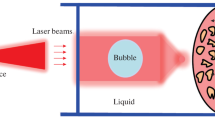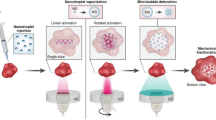Abstract
In the medical ultrasound field, microbubbles have recently been the subject of much interest. Controlling actively the effect of the microbubbles, a novel therapeutic method has been investigated. In this paper, our works on high intensity focused ultrasound (HIFU) lithotripsy with cavitating microbubbles are reviewed and the cavitation detection method to optimize the HIFU intensity is investigated. In the HIFU lithotripsy, collapse of the cloud cavitation is used to fragment kidney stones. Cloud cavitation is potentially the most destructive form of cavitation. When the cloud cavitation is acoustically forced into a collapse, it has the potential to concentrate a very high pressure. For the control of the cloud cavitation collapse, a novel two-frequency wave (cavitation control [C-C] waveform) is designed; a high-frequency ultrasound pulse (1–4 MHz) to create the cloud cavitation and a low-frequency trailing pulse (500 kHz) following the high-frequency pulse to force the cloud into collapse. High-speed photography showed the cavitation collapse on the stone and the shock-wave emission from the cloud. In vitro erosion tests of model and natural stones were also conducted. In the case of model stones, the erosion rate of the C-C waveform showed a distinct advantage with the combined high- and low-frequency waves over either wave alone. For the optimization of the high-frequency ultrasound intensity, the subharmonic acoustic pressure was examined. The results showed relationship between the subharmonic pressure from cavitating bubbles induced by the high-frequency ultrasound and eroded volume of the model stones. Natural stones were eroded and most of the resulting fragments were less than 1 mm in diameter. The method has the potential to provide a novel lithotripsy system with small fragments and localized cavitating bubbles on a stone.








Similar content being viewed by others
References
Bailey MR, Blackstock DT, Cleveland RO, Crum LA (1999) Comparison of electrohydraulic lithotripters with rigid and pressure-release ellipsoidal reflectors. II. Cavitation fields. J Acoust Soc Am 106:1149–1159. doi:10.1121/1.427123
Carnel MT, Alcock RD, Emmony DC (1993) Optical imaging of shock waves produced by a high-energy electromagnetic transducer. Phys Med Biol 38:1575–1588. doi:10.1088/0031-9155/38/11/003
Cathignol D, Tavakkoli J, Birer A, Arefiev A (1998) Comparison between the effects of cavitation induced by two different pressure-time shock waveform pulses. IEEE Trans Ultrason Ferroelectr Freq Control 45:788–799. doi:10.1109/58.677729
Church CC (1989) A theoretical study of cavitation generated by an extracorporeal shock wave lithotripter. J Acoust Soc Am 86:215–227. doi:10.1121/1.398328
Cleveland RO, Bailey MR, Fineberg N et al (2000) Design and characterization of a research electrohydraulic lithotripter patterned after the Dornier HM3. Rev Sci Instrum 71:2514–2525. doi:10.1063/1.1150643
Coleman AJ, Saunders JE, Crum LA, Dyson M (1987) Acoustic cavitation generated by an extracorporeal shockwave lithotripter. Ultrasound Med Biol 13:69–76. doi:10.1016/0301-5629(87)90076-7
Crum LA (1988) Cavitation microjets as a contributory mechanism for renal calculi disintegration in ESWL. J Urol 140:1587–1590
d’Agostino L, Brennen CE (1989) Linearized dynamics of spherical bubble clouds. J Fluid Mech 199:155–176. doi:10.1017/S0022112089000339
Evan AP, Lynn R, Willis LR, McAteer JA et al (2002) Kidney damage and renal functional changes are minimized by waveform control that suppresses cavitation in shock wave lithotripsy. J Urol 168:1556–1562. doi:10.1016/S0022-5347(05)64520-X
Ikeda T, Yoshizawa S, Tosaki M, Allen JS, Takagi S, Ohta N, Kitamura T, Matsumoto Y (2006) Cloud cavitation control for lithotripsy using high intensity focused ultrasound. Ultrasound Med Biol 32:1383–1397. doi:10.1016/j.ultrasmedbio.2006.05.010
Kaneko Y, Maruyama T, Takegami K, Watanabe T, Mitsui H, Hanajiri K, Nagawa H, Matsumoto Y (2005) Use of a microbubble agent to increase the effects of high intensity focused ultrasound on liver tissue. Eur Radiol 15:1415–1420. doi:10.1007/s00330-005-2663-7
Lauterborn W (1976) Numerical investigation of nonlinear oscillations of gas bubbles in liquids. J Acoust Soc Am 59:283–293. doi:10.1121/1.380884
Loske AM, Prieto FE, Fernández F, van Cauwelaert J (2002) Tandem shock wave cavitation enhancement for extracorporeal lithotripsy. Phys Med Biol 47:3945–3957. doi:10.1088/0031-9155/47/22/303
Matsumoto Y, Allen JS, Yoshizawa S, Ikeda T, Kaneko Y (2005) Medical ultrasound with microbubbles. Exp Therm Fluid Sci 29:255–265. doi:10.1016/j.expthermflusci.2004.05.008
McAteer JA, Williams JC, Cleveland RO et al (2005) Ultracal-30 gypsum artificial stones for research on the mechanisms of stone breakage in shock wave lithotripsy. Urol Res 33:429–434. doi:10.1007/s00240-005-0503-5
O’Neil HT (1949) Theory of focusing radiators. J Acoust Soc Am 21:516–526. doi:10.1121/1.1906542
Philip A, Delius M, Scheffczyk C et al (1993) Interaction of lithotripter generated shock waves with air bubbles. J Acoust Soc Am 93:2496–2509. doi:10.1121/1.406853
Pishchalnikov YA, Sapozhnikov OA, Bailey MR et al (2003) Cavitation bubble cluster activity in the breakage of kidney stones by lithotripter shockwaves. J Endourol 17:435–446. doi:10.1089/089277903769013568
Sapozhnikov OV, Khokhlova VA, Williams JC Jr et al (2002) Effect of overpressure and pulse repetition frequency on cavitation in shock wave lithotripsy. J Acoust Soc Am 112:1183–1195. doi:10.1121/1.1500754
Sokolov DL, Bailey MR, Crum LA (2001) Use of a dual-pulse lithotripter to generate a localized and intensified cavitation field. J Acoust Soc Am 110:1685–1695. doi:10.1121/1.1394221
Sokolov DL, Bailey MR, Crum LA (2003) Dual-pulse lithotripter accelerates stone fragmentation and reduces cell lysis in vitro. Ultrasound Med Biol 29:1045–1052. doi:10.1016/S0301-5629(03)00887-1
Tachibana K, Tachibana S (1995) Albumin microbubble echo-contrast material as an enhancer for ultrasound accelerated thrombolysis. Circulation 92:1148–1150
Taniyama Y, Tachibana K, Hiraoka K, Namba T, Yamasaki K, Hashiya N, Aoki M, Ogihara T, Kaneda Y, Morishita R (2002) Local delivery of plasmid DNA into rat carotid artery using ultrasound. Circulation 105:1233–1239. doi:10.1161/hc1002.105228
Umemura S, Kawabata K, Sasaki K (1997) In vitro and in vivo enhancement of sonodynamically active cavitation by second-harmonic superposition. J Acoust Soc Am 101:569–577. doi:10.1121/1.418120
Umemura S, Kawabata K, Sasaki K (2005) In vivo acceleration of ultrasonic tissue heating by microbubble agent. IEEE Trans Ultrason Ferroelectr Freq Control 52:1690–1698. doi:10.1109/TUFFC.2005.1561623
Williams JC, Stonehill MA, Colmenares K et al (1999) Effect of macroscopic air bubbles on cell lysis by shock wave lithotripsy in vivo. Ultrasound Med Biol 25:473–479. doi:10.1016/S0301-5629(98)00149-5
Xi X, Zhong P (2000) Improvement of stone fragmentation during shockwave lithotripsy using a combined EH/PEAA shock-wave generator—in vivo experiments. Ultrasound Med Biol 26:457–467. doi:10.1016/S0301-5629(99)00124-6
Yoshizawa S, Ikeda T, Takagi S, Matsumoto Y (2004) Nonlinear ultrasound propagation in a spherical bubble cloud. In: Proceedings of Ultrasonics Symposium 2004 IEEE, vol 2, pp 886–889
Zhong P, Cocks FH, Cioanta I, Preminger GM (1997) Controlled, forced collapse of cavitation bubbles for improved stone fragmentation during shock wave lithotripsy. J Urol 158:2323–2328. doi:10.1016/S0022-5347(01)68243-0
Zhu S, Cocks FH, Zhong P et al (2002) The role of stress waves and cavitation in stone comminution in shock wave lithotripsy. Ultrasound Med Biol 28:661–671. doi:10.1016/S0301-5629(02)00506-9
Acknowledgments
The authors thank Dr. James McAteer (Indiana University School of Medicine) for supplying the model stones used in this study. This work was supported by the Grant-in-Aid for Scientific Research and the 21st Century COE Program, “Mechanical Systems Innovation,” by the Ministry of Education, Culture, Sports, Science and Technology of Japanese.
Author information
Authors and Affiliations
Corresponding author
Rights and permissions
About this article
Cite this article
Yoshizawa, S., Ikeda, T., Ito, A. et al. High intensity focused ultrasound lithotripsy with cavitating microbubbles. Med Biol Eng Comput 47, 851–860 (2009). https://doi.org/10.1007/s11517-009-0471-y
Received:
Accepted:
Published:
Issue Date:
DOI: https://doi.org/10.1007/s11517-009-0471-y




